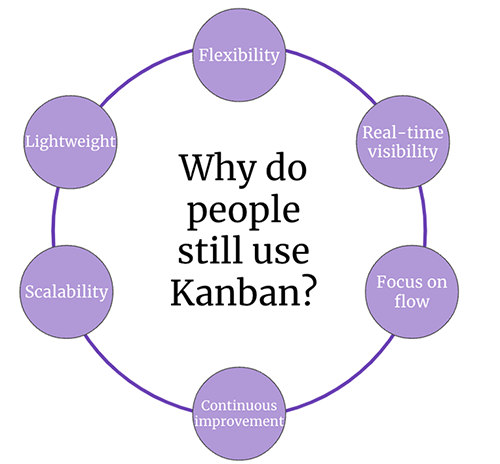In agile development, we often refer to a few frameworks when discussing ways of working and improvements — scrum, Kanban, SAFe, DAD, etc, to name a few.

In this article, we will zero in on the Kanban method and why people still use it today. We’ll go over its origin, its benefits, how to implement it in practice and at scale, and its challenges.
Kanban is one of the oldest frameworks in agile development. Its purpose is to visualize work and work status to create transparency between development teams and the rest of the organization. The goal is to visualize capacity, ongoing work, and priorities in real time to cue the next action and keep work flowing.
Taiichi Ohno, an industrial engineer at Toyota, coined the term Kanban in the 1970s. He created it through his new system of evaluating the supply of components. Kanban regulated it through an instruction card system sent along the production line.
The meaning of the word “Kanban” in Japanese is a billboard or visual sign. Kanban is a method for managing and organizing work to maximize efficiency and flexibility. In the modern day, it is often used in manufacturing and software development but can be applied to any field that involves the coordination of tasks.
When the agile ways of working were in their initial phase, Kanban was one of the first frameworks that helped establish the grounds for agile development.
Despite being in use for many years, Kanban is still one of the most widely-used frameworks in many organizations and is often used as the founding framework while adapting to agile ways of working.
The answer is simple: because of its simplicity and flexibility.
In modern days of digitalization, things move quickly, and the expectation is to deliver new development continuously at speed. This requires a method to track and understand the ongoing work and the status of identified work.
Kanban is the simplest way of visualizing the status of the work and understanding the next best action to keep the flow going. It helps prevent bottlenecks and visualizes potential blockers clearly and early for a smooth flow of the process.
Kanban framework can be used for both short-term projects, such as web design, or long-term projects, such as product development. By using Kanban, teams can break down large tasks into smaller manageable chunks and focus on one task at a time. This helps them stay focused on the task at hand and achieve speed with better results.
Despite the availability of other advanced agile methodologies, people still use Kanban for several reasons.

Kanban can adapt to suit the needs of different teams and organizations. It is not prescriptive and allows teams to work in the way that’s best for them.
The method provides real-time visibility into the work process, allowing teams to easily see what tasks are currently being worked on and what still needs to be done. This prevents bottlenecks and delays in the process.
As part of Kanban, teams are encouraged to focus on delivering small, incremental improvements regularly. This ensures that the team is always making progress and that work is completed on schedule.
A continuous improvement process allows teams to continuously review and adjust their process as needed, ensuring that they are always working at their best.
Kanban can scale up or down depending on the size of the team and the complexity of the work, allowing teams of all sizes to implement it.
Using this methodology is easy and doesn’t require a lot of upfront planning or documentation. This makes it less intimidating for teams to start using it.
Kanban can adapt to fit the needs of different teams and organizations, providing a simple yet powerful way to manage and organize work. It’s a popular choice among teams and organizations.
Before starting to implement Kanban, set clear guidelines and processes on how to use the Kanban board. A few examples of the guidelines can be: what will move the ticket to the next column entail and what should we check off the list while doing the move?
Once your guidelines are set, there are a few simple steps in which a basic Kanban system can move into practice.
To successfully implement Kanban in your product organization, involving all team members in the process is important. This includes developers, designers, managers, and other stakeholders. By getting everyone on board with the Kanban system, you can ensure that everyone is working towards the same goals and that everyone understands how the system works.
Additionally, it is important to establish clear guidelines for how using th Kanban board should be used. This includes setting limits on the number of tasks that can be assigned to each team member and establishing a process for how tasks should be moved from one column to another.
Finally, it is important to review the Kanban board and regularly make adjustments as needed. This includes removing completed tasks and reassessing priorities as new information becomes available. By periodically reviewing the board, you can ensure that the system is working as intended and that your team is making steady progress toward its goals.
Recently, Kanban has gained popularity among large legacy organizations trying to adapt to agile development methods. They want to prioritize and get a complete picture of each initiative at a higher level.
Because of the simplicity of the Kanban method, it easy to integrate with any scaled agile framework to secure transparency in a larger organization — where departments often work in silos. To create this standard view and break silos, the organization needs to develop a shared understanding.
Besides software development, Kanban has also gained popularity in other parts of the organization, including marketing, content creation, etc. This is because it follows a simple process: define your goals, create tasks, assign tasks to members, track progress, and adjust as needed.
This allows teams to adapt their strategies and make changes when needed quickly. It also helps software development teams in turn, since now the entire organization can understand and follow similar ways of working. It makes it easier to communicate and minimizes additional documentation to fulfill different ways of working needed for different departments.
Integrating Kanban with other agile frameworks can be a powerful way to improve your current process. However, to do so, you need first to understand the principles of Kanban. Then, you need to determine the right agile framework and identify areas that need improvement.
Start with small pilot projects, incorporating Kanban into your existing processes, then continuously improve and educate your team and regularly measure the success. This way, you can successfully integrate Kanban with other agile frameworks.
Kanban can be used at all levels, at any scale. Management can use Kanban for prioritizing initiatives on a higher level by using a “strategic Kanban” approach. This approach involves using Kanban boards and methods to visualize, manage, and prioritize initiatives at the organization’s strategic level.
First, create a Kanban board and add all the initiatives on a higher level to create transparency in the organization.
Explicitly state how initiatives should be moved from one column to another. This will help ensure consistency in the process so that everyone understands it. For example, the initiative can only be moved from backlog to the next column if the initiative is approved by all the cross-functional teams that are involved in the development and prioritized and allocated time and resources to it.
Next, regularly review the board and make necessary adjustments, including reassessing priorities, removing completed initiatives, and making any necessary process changes.
Communicate the status of initiatives to stakeholders and get their feedback. This will help to ensure that everyone is on the same page and that the initiatives align with the organization’s overall strategy. In this scenario, the stakeholders are the CFTs working with the initiatives like UX, marketing, sales, etc.
Next, track metrics such as lead time, cycle time, and work in progress to determine the success of the initiatives. This is extremely important. Management will be able to make adjustments as needed and ensure the initiatives align with the organization’s overall strategy.
This way, there is full transparency while prioritizing the initiative on the management level. The entire organization will avoid clashes and blockers in the future and help the CFTs carry on with their work smoothly.
Despite the benefits of Kanban, it is not without its challenges. One common issue is that team members may feel overwhelmed by the number of tasks on their plate, especially if the Kanban board is not updated regularly. To prevent this, it is important to regularly review the board and remove any completed tasks or tasks that are no longer relevant.
Another challenge is that team members may be hesitant to move tasks from one column to another, as they may feel that they haven’t completed the task to their satisfaction. Or, they may move them too quickly if there are no standards in place, such as a checklist for moving the item to the next column.
Have regular retrospectives with your team to establish if the way of working is helping them with their day-to-day or needs some improvement. Get feedback and try to revise the way of working. The requirements of the team may change based on the maturity level they’re at with respective projects.
Product managers can use Kanban to their advantage. It’s a great tool to visualize, manage, and prioritize the product development process. Kanban boards help with prioritizing product features, limiting work in progress, making process policies explicit, reviewing and adjusting, communicating with stakeholders, and measuring success.
By following these steps, the product manager can ensure that the product development process is aligned with the organization’s overall strategy and that the team is focusing on the most important features. Like any other framework or way of working, this method too needs continuous improvement and changes based on the team’s needs at any particular point.
Due to the simplicity and flexibility of the Kanban framework, it is highly mouldable to the needs of the teams, which makes it easy to adapt to.
Featured image source: IconScout

LogRocket identifies friction points in the user experience so you can make informed decisions about product and design changes that must happen to hit your goals.
With LogRocket, you can understand the scope of the issues affecting your product and prioritize the changes that need to be made. LogRocket simplifies workflows by allowing Engineering, Product, UX, and Design teams to work from the same data as you, eliminating any confusion about what needs to be done.
Get your teams on the same page — try LogRocket today.

A practical five minute revenue estimation method to help product managers compare ideas, drop low impact features, and prioritize smarter.

A practical guide for PMs who want to stop being bottlenecks, delegate smarter, and lead teams effectively with a clear ownership framework.

Stop letting unreliable data block features. Treat data as inventory to track quality, ownership, and ship with confidence.

Learn why slide decks slow teams down and explore better tools like whiteboards, PRDs, and prototypes to improve collaboration and alignment.